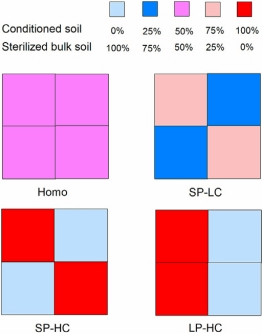Spatial heterogeneity in plant-soil feedbacks (PSFs) has been evidenced to influence plant growth. However, it is unclear whether patch size and contrast of PSF heterogeneity influence plant growth. We first conditioned a background soil by seven species separately and then grew each of them in a homogeneous soil and three heterogeneous soils. The first heterogeneous soil (large patch and high contrast; LP-HC) consisted of two large patches, of which one was filled with the sterilized background soil and the other with the conditioned soil. The second heterogeneous soil (small patch and high contrast; SP-HC) consisted of four small patches, of which two were filled the sterilized background soil and the other two with the conditioned soil. The third heterogeneous soil (small patch and low contrast; SP-LC) also consisted of four patches, of which two were filled with a 1:3 (w:w) mixture and the other two with a 3:1 mixture of the sterilized background soil and the conditioned soil. In the homogeneous soil, all patches were filled with a 1:1 mixture of the two soils. Both shoot biomass and root biomass were equal in the homogeneous and heterogeneous soils. No significant growth difference was observed between the SP-HC and LP-HC heterogeneous soil. However, shoot biomass and root biomass of the legume Medicago sativa, and root biomass of the grass Lymus dahuricus were greater in the SP-HC heterogeneous soil than in the SP-LC heterogeneous soil, probably due to enhanced root growth in the conditioned soil. Moreover, plant growth in the heterogeneous soils was associated with plant growth but not soil nutrient availability at the end of the conditioning phase. Our results show for the first time that patch contrast of PSF heterogeneity can influence plant growth via changing root placement and highlight the importance of fundamentally different facets of PSF variability.
